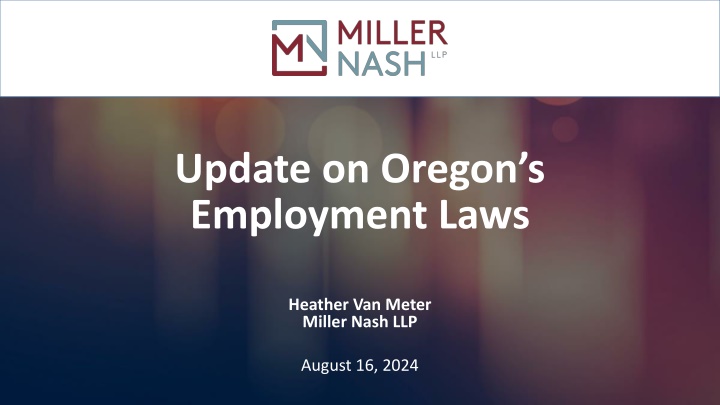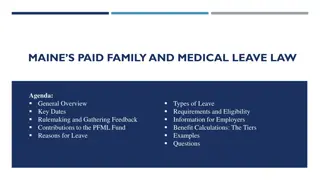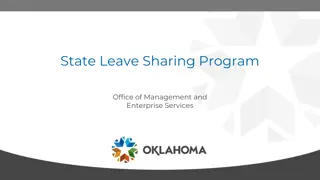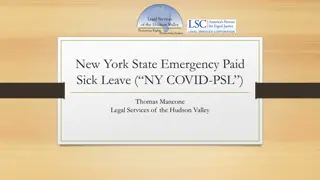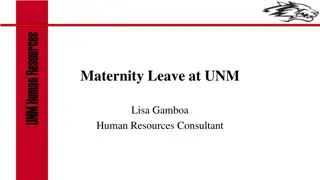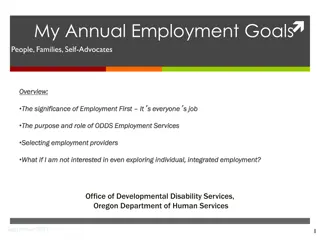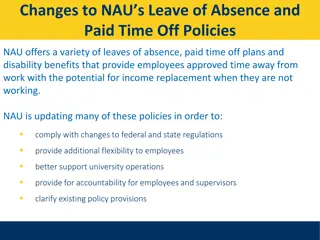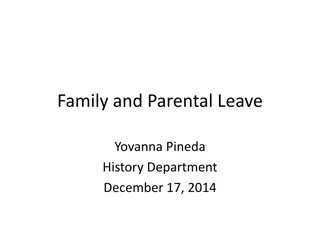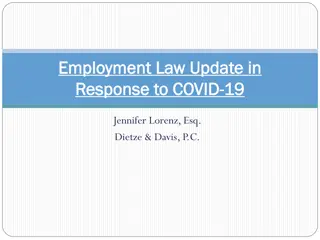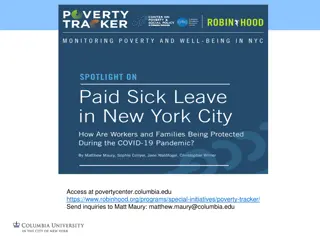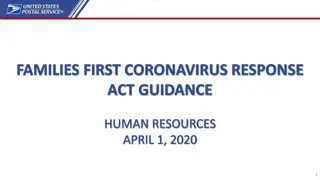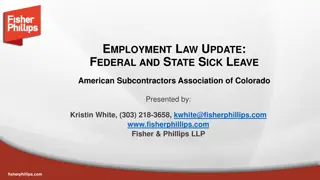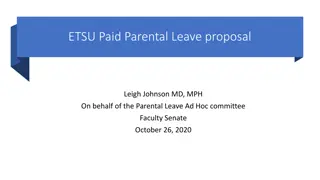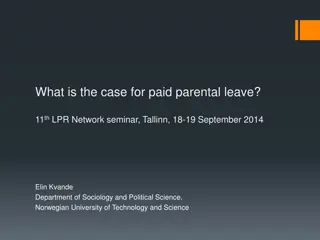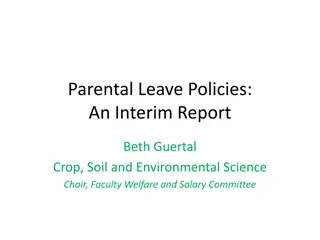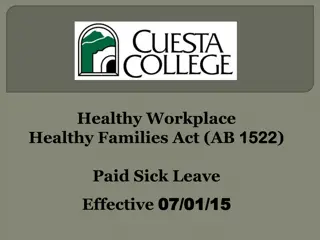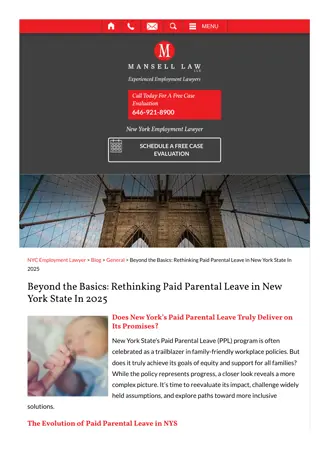Update on Oregon's Employment Laws - Paid Leave Program Overview
Paid Leave Oregon: A comprehensive overview of the state's paid family and medical leave program, including coverage details, contributions, available leave reasons, and effective dates. Employers and employees share contributions to a fund administered by the Oregon Employment Department. Explore the program's benefits, requirements, and covered scenarios.
Download Presentation

Please find below an Image/Link to download the presentation.
The content on the website is provided AS IS for your information and personal use only. It may not be sold, licensed, or shared on other websites without obtaining consent from the author.If you encounter any issues during the download, it is possible that the publisher has removed the file from their server.
You are allowed to download the files provided on this website for personal or commercial use, subject to the condition that they are used lawfully. All files are the property of their respective owners.
The content on the website is provided AS IS for your information and personal use only. It may not be sold, licensed, or shared on other websites without obtaining consent from the author.
E N D
Presentation Transcript
Update on Oregons Employment Laws Heather Van Meter Miller Nash LLP August 16, 2024
Paid Leave OregonA Refresher What is it? A paid family and medical leave program for employees working in Oregon. Employers and employees share contributions to a fund through payroll contributions collected by the Department of Revenue and administrated by the Oregon Employment Department unless they have received approval for an equivalent plan. Went into effect January 1, 2023 (for premium collection/contribution) and employees could begin taking leaves on September 3, 2023.
Paid Leave OregonCoverage Which employers are covered? All employers with one or more employees working in Oregon 25 employees or less not required to contribute toward premiums 25 employees or more must contribute 40 percent of the total 1 percent contribution rate, and employees pay 60 percent; employers are permitted to pay more, if they wish to do so Few exceptions Federal government Tribal government (may opt in)
Paid Leave OregonContributions How much are current contributions and how are they shared? Contributions are based upon a percentage of employee wages. The rate for 2024 is 1% of up to the first $168,600 in wages. Employees pay 60% of the set contribution rate, and Large employers (25+ employees) pay 40%. For example, if an employee made $1,000 in wages, the employee would pay $6 and a large employer that is required to contribute would pay $4. NOTE: Contribution requirements expected to rise due to costs of program!!!
Paid Leave OregonCovered Reasons What kinds and amounts of leave are available? Up to 12 weeks of paid leave to: Care for and bond with a new child within the first year after birth, adoption, or foster placement; Recover from a serious health condition; Care for a family member with a serious health condition; Use for safe leave (such as medical treatment for assault; counseling or other victim services related to domestic violence, sexual assault or stalking of themselves or a minor dependent; or relocation for health and safety reasons). Where the need for leave involves the employee s pregnancy, childbirth, or related medical condition, an additional two weeks of paid leave will be available under the program.
Paid Leave OregonNotice Posting/Notice Requirements Must post the model notice in the workplace AND must provide a copy to any employee working remotely. Employees may be required to share the following details: The type of leave they are taking (medical, family, safe) Why they need to take leave (their covered life event) When and for how long they expect to take leave. If they don t know exactly when or how much leave they will take, they can give you an estimate. Employers can t ask for any other information about their leave.
Paid Leave OregonReinstatement Reinstatement Rights After taking PLO, an employee has the right to return to their prior job, similar to FMLA/OFLA protections. The employee must have worked for their employer for 90 days to have these rights. Employers with fewer than 25 employees do not have to reinstate if the employee s position no longer exists. REMINDER: Employees cannot be required to use PLO, it must be their choice. That said, if they don t take PLO and are absent, it is not job-protected unless another leave entitlement or employer policy provides such protection.
Paid Leave OregonPlace of Performance If an employee works in more than one state and in Oregon, whether the employee is eligible for Paid Leave Oregon contributions and benefits will depend on which state is considered to be the Place of Performance. Paid Leave Oregon has helpful guidance for making this determination that is available on the website, and it is also outlined in Oregon Administrative Rule 471-070-0300. For employees that primarily work in Oregon, even if employees live in another state, occasionally work in another state, or if the business is located/headquartered in another state but the employee works remotely from Oregon, they must pay contributions and are eligible for PLO.
Paid Leave OregonPlace of Performance What about hybrid or fully remote employees in Washington? It depends on where each employee in your business works. Paid Leave Oregon uses the same localization standards as the federal unemployment insurance program and Washington Paid Leave program. If your employee works regularly or primarily in Oregon, and any work done outside of Oregon is minor, you will collect employee contributions and pay employer contributions to Paid Leave Oregon on all wages earned in Washington and Oregon. However, if they don t work with regularity in Oregon, or work exclusively in Washington, then their time would be considered localized to Washington and you would need to report and contribute through Washington s Paid Family and Medical Leave program.
S.B. 1515Paid Leave Oregon and OFLA As of July 1, 2024, OFLA has been streamlined to overlap, OFLA is now in addition to any leave available to the employee under PLO and cannot be applied concurrently. However, if the employee takes PLO and they have available FMLA, then the leaves will run concurrently. OFLA now only covers 4 situations: (1) Sick Child Leave - up to 12 weeks to care for employee s child suffering from condition requiring home care or due to closure of school or childcare during statewide public health emergency; (2) Pregnancy Disability Leave - up to 12 additional weeks off because pregnancy or childbirth disability; (3) Military Family Leave - up to 14 days if the employee s spouse or domestic partner is a service member who has been called to active duty or is on leave from active duty; and (4) Bereavement Leave: Up to two weeks of bereavement leave for the death of a family member, used within 60 days of death, not to exceed four weeks total per year. Child Placement Leave: Until 12/31/2024 OFLA covers an eligible employee taking up to two additional weeks of leave to facilitate the legal processes required for placement of a foster child or adoption. Paid Leave Oregon will cover this as of 2025.
S.B. 1515Interplay with Sick Leave Use of Sick Leave Changes clarified that an employee on PLO may elect to use available paid leave benefits (sick/vacation/PTO) in accordance with the employer s policies but that the amount used may not result in the employee receiving more than 100 percent of their regular weekly wage while they are using PLO.
Parental and Pregnancy Max 38-Week Maximum Potential Parental & Pregnancy Leave 12 weeks of unpaid pregnancy disability under OFLA; plus 2 weeks of paid pregnancy disability under PLO; plus 12 weeks of PLO/FMLA for serious health condition and/or parental bonding; plus 12 weeks of sick child leave under OFLA if child has sickness. Employees can also use available employer-provided leave, including Oregon mandatory paid sick leave, to extend this leave if employee has available paid leave from the employer!
Current Heat and Smoke Rules HEAT RULES (June 15, 2022) apply to outdoor and indoor work activities (when no AC/heat pump), when heat index equals or exceeds 80 degrees Fahrenheit, requiring: One or more shade areas immediately, readily available to employees working outdoors. Adequate drinking water, with immediate availability, free, and opportunity to drink. When heat index equals or exceeds 90 degrees F, must use a rest-break schedule for employee cool-down periods (hourly is common) as part of paid work assignments. Must gradually adapt employees to working in heat/prevent illness. Have written heat illness prevention plan providing above information and expectations for all employees to report when they need breaks, feel overheated, etc. with supervisor and employee training. SEPARATE RULES for heat in employer-provided worker housing!
Current Heat and Smoke Rules WILDFIRE SMOKE RULES (July 1, 2022) applies to employees who are or will be exposed to wildfire smoke where the ambient air concentration for fine particulate matter equals or exceeds an Air Quality Index (AQI) 101 (use weather app on phone!): Requires employee AQI exposure monitoring and training. Requires communications to relay information before employees are exposed. Requires using controls, including relocating outdoor workers to inside buildings where air can be adequately filtered, relocating work, or changing work schedule to better air quality. AQI 101+ requires employers to provide NIOSH-approved filtering respirator, such as a N95, to all exposed employees for voluntary use (employers must require employees wear respirator at AQI 251+) AQI 501+ requires employers to follow medical monitoring, fit testing, and other Respiratory Protection Standard requirements.
Resources Free OSHA fact sheets about key heat rule requirements in Spanish and English. Free Oregon OSHA consultations for employers to improve workplace safety and health programs no fault, no citations, no penalties. Free resources available from SAIF on heat and wildland smoke. Free OSHA Wildland Smoke online course in Spanish and English. Free DEQ Online Fact Sheet Using the Air Quality Index (AQI) to Assess Wildfire Smoke
Overtime Rules in Agriculture Per HB 4002 (2022): Starting January 1, 2023, employers are required to pay overtime to agricultural workers after they work 55 hours in one workweek. Starting January 1, 2025, employers will be required to pay overtime to agricultural workers after they work 48 hours in one workweek. Starting January 1, 2027, employers will be required to pay overtime to agricultural workers after they work 40 hours in one workweek.
Overtime Rules in Agriculture OAR 839-020-0004(6) definition: Agriculture includes farming in all its branches and among other things includes the cultivation and tillage of the soil, dairying, the production, cultivation, growing, and harvesting of any agricultural or horticultural commodities, the raising of livestock, bees, fur-bearing animals, or poultry and any practices performed by a farmer or on a farm as an incident to or in conjunction with such farming operations, including preparation for market, delivery to storage or to market or to carriers for transportation to market. Agricultural employment is employment in Agriculture as herein defined.
Overtime Rules in Agriculture Special notes: ORS 653.265 requires the payment of overtime to employees who work more than 10 hours per day in canneries, driers, and packing plants, excluding those that are located on farms which primarily process products produced on such farms. ORS 652.020 may require the payment of daily overtime (after 10 hours in a day) and impose a maximum limit to hours worked each day of 13 hours when operations of the establishment constitute manufacturing . See ORS 652.020(1)(b); OAR 839-001-0100(14). Manufacturing means the process of using machinery to transform materials, substances, or components into new products.
Overtime Rules in Agriculture How is overtime for piece-rate work calculated if an agricultural worker does not receive an hourly wage? BOLI Example: An ag worker earns $900 piece rate working 60 hours in a workweek. Step 1: Calculate the hourly rate of pay. $900/60 hours = $15/hour Step 2: Calculate overtime hours. 60 hours - 55 hours = 5 hours overtime Step 3: Calculate the overtime rate by multiplying the hourly rate by 0.5. $15/hour x 0.5 = $7.50 owed/overtime hour Step 4: Calculate how much overtime pay is owed. $7.50 owed/overtime hour x 5 hours overtime = $37.50 overtime pay is owed Note: The rate of pay (Step 1) may change on a weekly basis if the employee is earning a different amount in piece-rate earnings and working different hours each week. All work and piece-work must be tracked daily by employer.
Overtime Rules in Agriculture How is overtime calculated for ag workers who work both hourly and for piece-rate pay? BOLI Example: An ag worker earns $500 piece rate while working 25 hours, and earns $525 while working 35 hours at an hourly rate of $15/hour in the same workweek. Step 1: Calculate hourly rate of pay for piece-rate earnings. $500/25 hours = $20/hour Step 2: Calculate total straight-time pay by adding total piece-rate earnings and total hourly earnings. $500 + $525 = $1025 Step 3: Calculate weighted average by dividing the total straight-time pay by the number of hours worked. $1025/60 =$17.08 Step 4: Calculate overtime rate by multiplying the weighted average by 0.5. $17.08 x 0.5 = $8.54 owed/overtime hour Step 5: Calculate overtime hours. 60 hours - 55 hours = 5 hours overtime Step 6: Calculate how much overtime pay is owed. $8.54 owed/overtime hour x 5 hours overtime = $42.70 overtime pay is owed Step 7: Calculate weekly gross pay by adding straight-time pay (Step 2) and overtime paid owed (Step 6). $1025 + $42.70 = $1067.70 weekly gross pay
Overtime Rules in Agriculture General overtime rule (non-agriculture) OAR 839-020-0030(1) states: all work performed in excess of forty (40) hours per week must be paid for at the rate of not less than one and one-half times the regular rate of pay when computed without benefits of commissions, overrides, spiffs, bonuses, tips or similar benefits pursuant to ORS 653.261(1). Similar benefits include, but are not limited to, discretionary bonuses, gifts, profit sharing, thrift and savings program, trusts, reimbursements for expenses, holiday, or vacation pay.
Exceptions to Overtime in Agriculture HB 4002 states overtime requirements for agricultural workers do not apply to: members of an employer s immediate family. local hand harvest or pruning workers who are paid piece rate and who worked fewer than 13 weeks during the previous calendar year. migrant hand harvest workers 16 or younger who are paid the same piece rate as workers over 16. harvest and pruning workers who are paid piece rate and work for an employer who did not exceed 500 piece-rate workdays of agricultural labor in any quarter of the previous calendar year. A piece- rate workday accrues each day an employee performs piece-rate agricultural labor for at least 1 hour. workers mainly engaged in the range production of livestock. any individual employed in agriculture whose principal duties are administrative, executive OR professional work, AND who perform predominantly intellectual, managerial, or creative tasks; exercise discretion and independent judgment; AND earn a salary and are paid on a salary basis (i.e. exempt workers).
Other Compensation Rules in Agriculture OAR 839-020-0013: Bonuses Provided to Workers in Agriculture (1) Every producer, or agent of the producer, who employs a labor contractor to provide a working crew for harvesting perishable agricultural products or who offers a bonus to those persons who harvest perishable agricultural products shall cause to be conspicuously posted and maintained on the premises where the agricultural products are to be harvested, a notice that states: (a) A description of the terms and conditions of any bonus offered, including the manner of determining when the bonus is earned; and (b) That portion of the labor contractor s compensation that is based on the amount of work done by each employee of the labor contractor. (2) Such notice must be written in the language customarily used by the employer or its agents to communicate with a worker. (3) The notice must be distributed in writing to workers, if required by ORS 658.440(1)(f) or any other law. (4) Any condition that has not been properly disclosed in the manners described above cannot be enforced against any worker to deny or diminish the amounts to which the worker would otherwise be entitled.
Thank You! Heather Van Meter, Partner Miller Nash LLP 360.619.7038 heather.vanmeter@millernash.com
